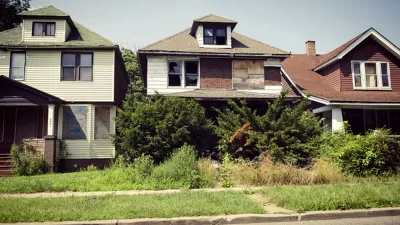As Detroit's efforts to stabilize its neighborhoods progress, valuable lessons and trends are emerging. One particularly bright spot was recently revealed: fewer homes are in need of demolition than originally thought.
Anna Clark provides a report from two neighborhoods in Detroit struggling to get a foothold in recovery, despite the ravages of decades of decline and the vacant properties that have followed. East English Village and MorningSide are the subjects of Clark's exploration—two neighborhoods on the East Side of Detroit at distinct stages of recovery relative to decline.
Specifically, Clark focuses on the efforts of the Detroit Land Bank Authority to stabilize and even improve the neighborhoods. For instance:
"Among the tactics: “judicious demolition.” Carrie Lewand-Monroe, senior adviser at the land bank, broke the news that the organization is reducing its estimate for the number of recommended demolitions in the city from the 80,000 cited in the 2014 Detroit Blight Removal Task Force Report to 40,000. More homes are rehabitable than previously thought."
Clark also details some of the programs in place to reactivate the lots created when vacant homes must still be demolished. Such programs include a new lot leasing program that will launch this summer, "where lots can be leased for $25 per year for up to three years. The only requirement is that the person with the lease has the approval of a block club for what they want to do with the lot."
The article includes more details about the work of the Detroit Land Bank Authority and the residents of East English Village and MorningSide in this massive recovery effort.
FULL STORY: Detroit Doesn’t Have to Demolish Nearly as Many Homes as Planned

Alabama: Trump Terminates Settlements for Black Communities Harmed By Raw Sewage
Trump deemed the landmark civil rights agreement “illegal DEI and environmental justice policy.”

Study: Maui’s Plan to Convert Vacation Rentals to Long-Term Housing Could Cause Nearly $1 Billion Economic Loss
The plan would reduce visitor accommodation by 25% resulting in 1,900 jobs lost.

Why Should We Subsidize Public Transportation?
Many public transit agencies face financial stress due to rising costs, declining fare revenue, and declining subsidies. Transit advocates must provide a strong business case for increasing public transit funding.

Paris Bike Boom Leads to Steep Drop in Air Pollution
The French city’s air quality has improved dramatically in the past 20 years, coinciding with a growth in cycling.

Why Housing Costs More to Build in California Than in Texas
Hard costs like labor and materials combined with ‘soft’ costs such as permitting make building in the San Francisco Bay Area almost three times as costly as in Texas cities.

San Diego County Sees a Rise in Urban Coyotes
San Diego County experiences a rise in urban coyotes, as sightings become prevalent throughout its urban neighbourhoods and surrounding areas.
Urban Design for Planners 1: Software Tools
This six-course series explores essential urban design concepts using open source software and equips planners with the tools they need to participate fully in the urban design process.
Planning for Universal Design
Learn the tools for implementing Universal Design in planning regulations.
Smith Gee Studio
Alamo Area Metropolitan Planning Organization
City of Santa Clarita
Institute for Housing and Urban Development Studies (IHS)
City of Grandview
Harvard GSD Executive Education
Toledo-Lucas County Plan Commissions
Salt Lake City
NYU Wagner Graduate School of Public Service



























